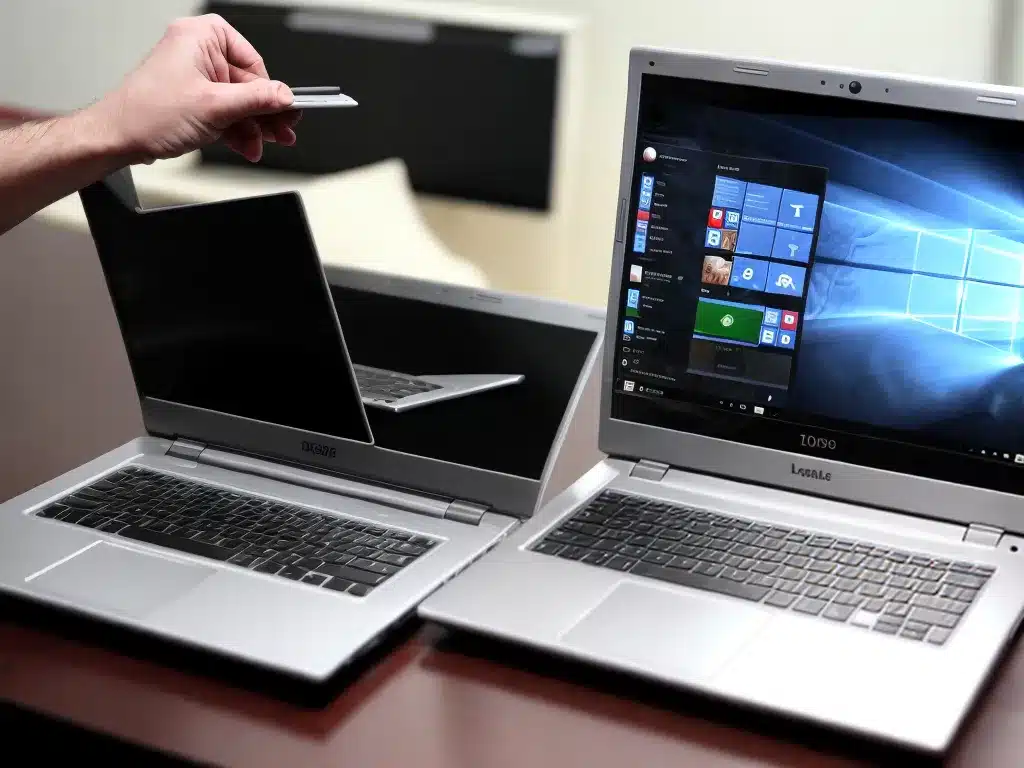
Having an overheating laptop can be extremely frustrating. High temperatures can lead to throttled performance, unexpected shutdowns, and even permanent hardware damage if left unchecked. Thankfully, there are quite a few things you can try to get your laptop running cooler again. Here are my top 10 tips for fixing an overheating laptop:
1. Clean Out the Fans and Vents
Dust buildup in the internal fan and vent system is a major culprit for overheating laptops. Loose dust bunnies and pet hair can clog up the fans and heat sinks, preventing proper airflow.
Use a can of compressed air to thoroughly clean out the keyboard, fan intakes, bottom case vents, and other openings. Hold fans in place when blowing air into them so they don’t spin out of control. Be very careful not to blow air towards sensitive components.
Cleaning the laptop internals this way every few months can help prevent overheating issues. Just be sure to do it in a well-ventilated area.
2. Elevate the Laptop for Better Airflow
Laptops left sitting flat on beds, couches, and other soft surfaces can easily have their bottom vents blocked. This prevents proper airflow and causes extra overheating.
Try using a solid laptop cooling pad, desk stand, or just place some books under the back edge to elevate the laptop when in use. This allows better airflow and can result in lower operating temperatures.
3. Check for Blocked Vents
In addition to elevating the laptop itself, check that the intake and exhaust vents aren’t blocked by other objects.
Using the laptop on a pillow or blanket, or setting something on top of the exhaust vent can completely smother airflow. Keep papers, books, chargers, etc from obstructing the vents.
4. Manage Tasks and Programs
Having too many resource-intensive programs and tasks running can overburden the laptop and contribute to heat buildup. The more work the CPU and GPU have to do, the hotter things get.
Close any inactive browser tabs and apps when not needed. Limit demanding tasks like gaming or video editing to short bursts. Use task manager to monitor which apps and background processes are using the most system resources.
5. Lower the Screen Brightness
The laptop screen’s backlight at maximum brightness requires considerably more battery power compared to lower brightness settings. This extra power draw and electricity use contributes to overheating.
Try lowering the screen brightness to the minimum level that is comfortable for your eyes. This one simple change can have a noticeable effect on lowering operating temperatures.
6. Switch to Battery Power
When plugged in and charging, laptops are under higher electrical load and generate more heat. The battery acts as a buffer and reduces strain on the components.
Unplug the laptop and switch to battery power when temps get too high. Just be sure to plug back in once things cool down to avoid draining the battery completely.
7. Update BIOS, Drivers, and Utilities
Outdated firmware, drivers, and utilities can sometimes cause stability issues that contribute to overheating. It’s a good idea to update to the latest BIOS, graphics drivers, chipset drivers, and management utilities.
Follow your laptop maker’s instructions to find and safely install any available updates. This can optimize performance and resolve overheating bugs.
8. Replace the Thermal Paste
The thermal paste between the CPU/GPU and heatsink dries out over time. This leads to inefficient transfer of heat away from the chips.
Carefully replacing the thermal paste of an aging laptop can significantly improve cooling, but does require dismantling the laptop. Follow a tutorial specific to your model.
9. Undervolt the CPU/GPU
Undervolting reduces the operating voltage supplied to computer chips. This lowers power use, temperatures, and sometimes increases stability too.
Carefully undervolting the CPU and GPU can help reduce an overheating laptop’s temps by several degrees. This requires a voltage adjustment utility compatible with your specific hardware.
10. Improve Airflow with Cooling Pads/Stands
External laptop cooling pads or stands with built-in fans can further help increase airflow and reduce internal temps. Models with large fans that align with the laptop’s intakes/exhausts tend to work best.
Just watch for pads that are noisy or drain too much additional power through the USB port. Proper airflow is key, so be sure vents aren’t obstructed.
In Closing
I hope these 10 tips give you some ideas on taming an overheating laptop. Start with simpler software fixes like cleaning fans, managing tasks, and improving airflow. For more stubborn heat issues, consider hardware solutions like new thermal paste or undervolting. An external cooling pad can also help strengthen airflow.
With a few tweaks, you can stop lappable scorching temperatures and enjoy stable PC performance once again! Let me know if you have any other tips for fixing overheating laptops too.












